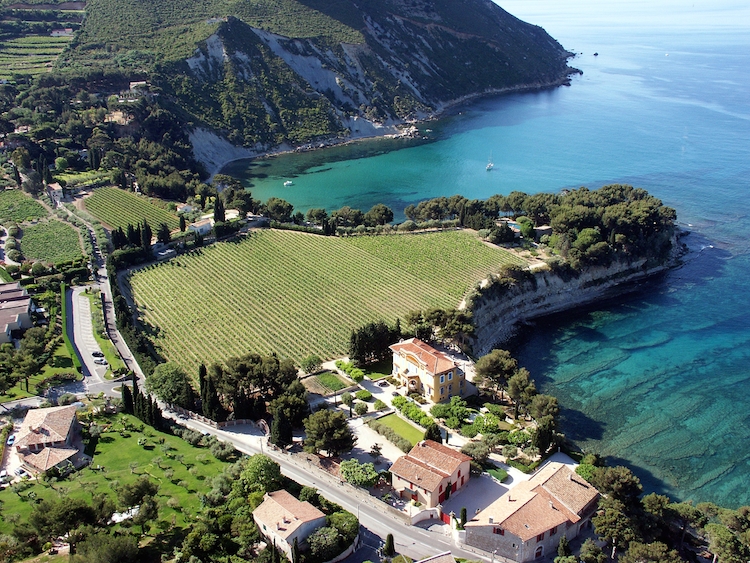From €15.50, £21.25, $25.99, CA$43.99, AU$45, 298.90 Norwegian krone
This really may be the last of this summer’s wine. Inspired by the Indian summer we experienced during our recent few days in New York and Connecticut, I have chosen a wine today that performs more or less the same function as the Bandol rosé I chose at the beginning of September: a quintessentially Provençal wine designed to prolong the summer, or at least memories of summer, for those of us in the northern hemisphere.
I was inspired by how much I enjoyed Clos Ste-Magdeleine Blanc 2015 Cassis with a salad of shaved fennel, celery heart, bottarga and Capezzana olive oil at King, a new restaurant in SoHo, New York, about which Nick will write tomorrow. I would normally automatically favour a younger vintage than one that is approaching its second anniversary for an intrinsically low-acid, full-bodied white but this 2015 had quite enough compelling herbal flavour and intriguing complexity to sustain my interest. This is the current vintage available widely in the US, as usual one year behind the vintage that’s easy to find in Europe, although the 2015 is also available in Norway, and in Canada.
Clos Ste-Magdeleine Blanc 2016 Cassis, currently on sale in France, the UK and Australia, is a fine example in the same vein, with the same breadth and appeal. The combination of Provençal scents with a hint of brine and pine, together with the wine’s polished, round texture that is just the right side of oily, is capable of transporting the taster immediately to a summer idyll.
The unusual assemblage – generally 40% Marsanne, 30% Ugni Blanc, 25% Clairette, 5% Bourboulenc – may be partly responsible for the wine’s undoubted appeal. Or perhaps the vine age of 20 to 30 years in the nine hectares of white wine vineyards. But it’s probably the unique situation of the vineyard.
Both US and UK importers, respectively Kermit Lynch and Yapp Bros, wax lyrical about the very special position of the vineyard, as well they might. Yapp describes ‘grapes grown on the slopes of France's highest sea cliff, the Cap Canaille. Sublime scenery and wondrous wine’. For Lynch the vineyards ‘jut out on a private cape to meet majestic limestone cliffs, poised spectacularly above the sparkling, azure Mediterranean.’ The aerial photograph below corroborates this in spades, and also shows what Yapp Bros describe as ‘François Sack’s art deco château’.

Sack is fourth generation, has converted the domaine to organic viticulture (as well he might in this warm, dry corner of France) and is now experimenting with a small-scale Marsanne-dominant (65%) cuvée called Bel-Arme that is fermented and aged in concrete eggs rather than stainless steel. Clos Ste-Magdeleine also make a tiny amount of rosé.
Cassis itself is an undeniably pretty little Mediterranean port that, just about, manages to retain its local character because it is not on the way to anywhere. Just east of Marseille, it’s the seaside focus of the Bandol vineyards and its eponymous wine, a bit like Bellet in the hinterland of Nice, is one of those tiny appellations that wine geeks are more likely to come across theoretically than practically.
Clos Ste-Magdeleine is the leading producer and the only one whose wines I have ever encountered, usually on the list of a southern French restaurant. (I think the main reason it, and a mature Terre Brune red Bandol, were on the list at King was that one of the partners and her husband had enjoyed a holiday in the region.)
Whenever I have tasted it I have enjoyed it, savouring its ability to partner all sorts of southern European foods – particularly dishes based on vegetables.
Because Cassis is a port and has its fair share of fish restaurants, the wine is usually described as being a perfect partner for fish, but I’m not sure it has quite enough acidity for perfection. Or maybe you just need to be sure of some acidity in the dish rather than in the wine.
One other factor in favour of this wine as far as I am concerned is that I cannot think of another wine that it resembles. It has none of the tension of the admirable Marsannes now being produced in St-Péray and is much more maritime than any other southern French Marsanne blend that I can think of. Its distinctiveness is surely one of its charms; I can imagine it being a hit at a dinner party as an alternative to white burgundy.
Considering the small production, this wine is relatively widely distributed. Wine-searcher.com lists stockists in the UK, US, Canada, France, Norway and Australia.














